Economic and Social Changes: Facts, Trends, Forecast @volnc-esc-en
Статьи журнала - Economic and Social Changes: Facts, Trends, Forecast
Все статьи: 1728

Inter-municipal cooperation as a factor promoting the economic and social development
Статья научная
The article deals with the concept of “inter-municipal cooperation”, it substantiates the importance of inter-municipal cooperation for socio-economic development. The article describes the basic models of inter-municipal cooperation and highlights their essential characteristics. Besides, it reveals the main problems, impeding the wide-scale usage of this institution in practice and proposes a stepwise algorithm of formation and development of inter-municipal cooperation.
Бесплатно
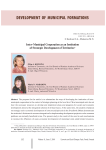
Inter-municipal cooperation as an institution of strategic development of territories
Статья научная
The purpose for the article is to substantiate the ways of developing the institution of inter-municipal cooperation in the context of strategic planning at the local level. Most municipal units do not have the necessary resources to develop and implement plans and programs for social and economic development aimed at the integrated solution of all local issues. At the same time, the analysis of projects on strategic socio-economic development of some municipal units in the Sverdlovsk Oblast demonstrates the territories’ disinterest in resource integration for implementing development projects to solve common problems on mutually beneficial terms. The present study is the result of the need to seek mechanisms to increase the efficiency of socio-economic development of municipal units amid limited resources. The authors propose a methodical basis of the multicomponent analysis of strategic development factors based on sectoral and territorial cooperation of municipal units...
Бесплатно
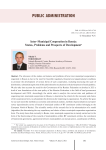
Inter-municipal cooperation in Russia: status, problems and prospects of development
Статья научная
The relevance of the studies on features and problems of how inter-municipal cooperation is organized in Russia is due to the need for favorable regulatory, financial and organizational conditions to promote the development of various forms of such cooperation, including increasing the scale of distribution, substantiating the role of this administrative mechanism in the development of municipalities. We also take into account the need for the Government of the Russian Federation to develop in 2021 a draft of new foundations of the state policy of the Russian Federation in the field of local government development until 2030. Accordingly, the article aims to analyze the current state and problems of organizing inter-municipal cooperation in Russia, to determine the criteria for the necessity and choice of the cooperation form, to substantiate the directions for improving its organization. To achieve the goal, we use such scientific methods as economic and statistical analysis, methods of generalization and expert survey (questionnaire survey of heads of municipal entities of RF constituent entities belonging to the European North of Russia). The scientific novelty of the research lies in the substantiation of a model (algorithm) for determining the very expediency and choice of inter-municipal cooperation organization form. The study shows that currently in Russia, inter-municipal cooperation is mainly carried out in the form of the functioning of the councils of municipalities within RF constituent entities, the conclusion of framework agreements, agreements between municipalities on mutual action, coordination of efforts, and implementation of joint activities. Only 2.8% of the total number of municipalities in the country participate in cooperation most closely (establishing inter-municipal organizations). We have developed appropriate recommendations to the authorities to eliminate the existing obstacles and problems in the development of inter-municipal cooperation. The results of the conducted research can be used in the activities of federal, regional public authorities, local government bodies, and serve as a basis for further research on improving local management system.
Бесплатно
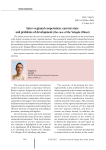
Статья научная
The article proves that the rate of economic growth to a large extent depends on the involvement of the region's economy in inter-regional relations. The econometric model of the relationship between inter-regional trade and investment in fixed assets, and the gross regional product can be used to assess the contribution of inter-regional relations into economic development. The analysis of the inter-regional relations of the Vologda Oblast reveals the main problems of their development, shows the possibilities of using the mechanisms of strategic planning aimed at enhancing the cooperation between the regions.
Бесплатно
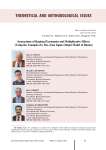
Статья научная
Currently, the key areas of Siberian economics include analyzing the economy and assessing the prospects of the Asian part of Russia. To achieve the goal, it is necessary to determine the contribution of the Asian part of Russia to the economy of other regions and the country as a whole. The aim of this work is to study the interaction of Russia's European and Asian parts. The input-output tables built in the Institute of Economics and Industrial Engineering, Siberian Branch of the Russian Academy of Sciences for the European and Asian economic zones as of 2019 allow us to assess the effects of regional interaction at the industry level using multiplicative analysis tools. The paper presents calculated regional and interregional coefficients of direct and total costs, as well as balance sheets reflecting the creation and use of products for European and Asian regions. The results of the study indicate that in the structure of direct costs of the European part of Russia, the weight of the Asian part is significant for the production of coke and petroleum products (about 44%), ferrous and non-ferrous metallurgy (about 15%) and other industries. In the structure of the total costs of the European part of Russia, a high proportion of the Asian part is observed for extractive industries, ferrous and non-ferrous metallurgy and oil refining industry, which is partly due to the specifics of recording the results of foreign trade. If we consider the balance of use of products from the Asian part of Russia, we see that 7.5% of the produced product goes to intermediate consumption and 3.0% is sent to meet the final demand of European regions. The results of the work can be used to measure the effects of public financing at the regional and federal levels. Due to the fact that indirect and full costs account for only those product flows that relate to intermediate consumption, it seems advisable in the future to elaborate on the methodology so as to include accounting for investment goods.
Бесплатно
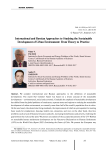
Статья научная
We consider international and Russian approaches to the definition of sustainable development. The report Our Common Future was based on a triune concept of the sustainable development - environmental, social and economic. Gradually the emphasis of sustainable development has shifted from the global problems of continents, separate states and regions to studying the sustainable development of urban environment, as currently more than half of the world’s population lives in cities. On the one hand, cities determine living standards, the improvement of which is a prerequisite for meeting basic needs for employment, housing, health care, education, and rest; on the other hand, they face problems such as lack of financial resources and jobs, increasing homelessness and poverty, widening the gap between the rich and the poor. We present an analysis of the accepted documents of the UN-Habitat on sustainable human settlements development on the Vancouver Declaration on Human Settlements (1976) to the World Cities Report 2022: Envisioning the Future of Cities. We present the European way through the European Charter. The main points and concepts of the sustainable development of big and small cities of Europe are considered from the Aalborg Charter (Denmark, 1994) to the Mannheim Message (Germany, 2020). We analyze northern city ranking, which has been implemented by the Rating agency SGM since 2013. We propose a methodology for assessing the sustainable development of northern cities on eight demographic and labor indicators; conduct a grouping of 115 cities of the Russian North on the types and indicators of the sustainable development, and mark 10 most sustainable cities and 10 - with the worst ranking. The considered theoretical provisions and practical results can be used for comparative studies and planning of territorial development. We suggest the directions for improving the sustainable development of Russia’s northern cities.
Бесплатно

International landscape of the market of Russian economic journals
Статья научная
The paper considers a new stage in the formation of the Russian market of economic journals, the stage at which an increasing number of them are accepted for coverage in international databases such as Scopus and Web of Science. In order to make an adequate assessment of the qualitative changes that have occurred in the market, we propose to introduce significant adjustments to the methodology for compiling the academic Rating of leading Russian economic journals. The adjustments affect both the subsystem of scientometric indicators where it takes into account the potential of high citations, and the subsystem of expert evaluation where it takes into account the publication's inclusion in the databases Scopus and Web of Science (WoS). We provide the results of the 4th wave of the Rating of leading Russian economic journals presented in the form of the Diamond List and the List of the second tier of journals. We analyze the shifts in the positions of the journals in comparison with previous years; we show that Russia already has 15 economic publications with international certification, among which five publications have double certification (both Scopus and WoS)...
Бесплатно
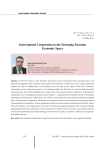
Interregional cooperation in the emerging Eurasian economic space
Статья научная
In 2015 the Treaty on the Eurasian Economic Union entered into force and presented a new stage of reintegration of the countries on the territory of the former USSR. The success of this project will depend not only on collaboration at the national level, but also on the degree of the EEU countries’ involvement in the integration process. The academic debate on this issue is a relevant and practically important task. The article highlights the results of the international online-conference “Interregional cooperation in the emerging Eurasian Economic Space”, conducted by the Institute of Socio-Economic Development of Territories of RAS June, 16-20 2015. It considers the issues associated with interregional trade and economic cooperation, interaction in the sphere of science and innovation and various aspects of humanitarian cooperation. It raises important problems of cross-border cooperation of the EEU states. The article makes a conclusion about the need to develop the integration process both in scope (through expanded directions of cooperation, which should not be limited only to contacts at the highest political level or trade partnership) and depth (through involvement of regions, enterprises, different social groups, individual citizens).
Бесплатно

Intraregional differentiation of demographic potential in the Republic of Tatarstan
Статья научная
The issues of formation of agglomerations are more considered from the economic point of view and as an effective way of infrastructural development of territories. However, the demographic aspects of studying the potential of the regions' territories are left without attention. The purpose of the research is to determine the zones of demographic risk and stability of the Republic of Tatarstan and identify the vector of demographic development of its three agglomerations. The theoretical analysis of the concept of “agglomeration” helps consider the unification of cities and municipal districts not from the geographical and economic perspective, but as a tool for effective development of human capital. The method of rapid analysis of demographic processes in the Republic of Tatarstan developed by the Center for Family and Demography at Tatarstan Academy of Sciences is a differentiated analysis of demographic prospects of agglomerations of the Republic taking into account their initial potential. In the article, based on the agglomeration approach we differentiated intra-regional demographic potential of municipal formations of the Republic. In order to determine the zones of demographic risk in three agglomerations, we calculated the integrated rank of municipal districts according to the main demographic indicators: total fertility rate, mortality, natural growth, marriage rate, divorce rate and migration gain. The article reviews in detail birth rate as the most important category of the region's socio-demographic development. The ranking of municipal districts of the Republic of Tatarstan included in various agglomerations, according to the current demographic situation, helps identify the region's prosperous zones at the present development stage. The definition of risk zones will help adjust the social and demographic policy of municipalities, thereby ensuring sustainable demographic development of the Republic of Tatarstan as a whole.
Бесплатно
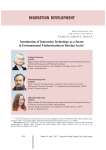
Introduction of innovation technology as a factor in environmental modernization in Russian Arctic
Статья научная
The paper considers the fundamentals of formation and realization of the modern Russian state environmental policy in the Arctic and analyzes environmental threats and challenges, including the impact of the mining and metallurgical complex on the environment. Coal industry and ferrous and nonferrous metallurgy are considered to be major producers and accumulators of waste. In the smelting of metals slags are formed, which are based on oxides. Sulfur oxides occupy one of the first places according to their negative impact on the environment. The present paper considers environmentally responsible business models in the Arctic, when the priority in management decisions is given to the issues of preserving nature and not just making profit. The main environmental issue is associated with the accumulation of waste in the places of concentration of objects of industry, transport, energy and social sphere in the confined spaces in those areas of the Arctic, where mineral deposits are exploited, raw materials are processed and transported...
Бесплатно
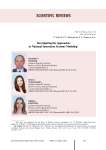
Investigating the Approaches to National Innovation Systems Modeling
Статья научная
The article analyzes some modern approaches to modeling national innovation systems that are presented in scientific literature. We use modern methods for analyzing bibliography and preparing literature reviews: co-occurrence, and the PRISMA (Preferred Reporting Items for Systematic Reviews and Meta-analyses) method. With the help of this approach we conduct relational analysis of documents by systematizing and arranging keywords into special semantic clusters that reflect interest in modeling national innovation systems. The research focuses on mathematical models of national innovation systems and models that use empirical quantitative data analyzed with the help of various econometric methods based on the Russian specifics of economic development. In this regard, when searching for and analyzing relevant sources, we used the filters “Russian innovation system”, “national innovation system and Russia”. We have revealed that the majority of publications focuses on such aspects as digitalization, neo-industrialization, innovation policy and technology. We identify four directions for modeling national innovation systems: macroeconomic modeling of innovation systems, modeling of growth based on the development of innovation systems, modeling of innovative activity of firms, modeling of institutional factors contributing to the development of innovation systems. The national innovation system is modeled mainly through the use of indicators related to patenting, the volume of exports and the production of innovations. Factors determining the development of national innovation systems in this context include R&D and innovation expenses, investment in technology, education, infrastructure, human resources and the quality of human capital. Conclusions on the analyzed models often do not coincide regarding the role of the state in financing innovations, the role of various elements of the institutional structure of the economy, such as intellectual property rights and mechanisms for their protection, as well as the role of political factors. On the other hand, the conclusions are consistent in terms of the impact of innovation on economic growth and development: we note a positive correlation with indicators reflecting the development of national innovation systems.
Бесплатно

Investigation of food supply in the Vologda region
Статья научная
The article proposes approaches to assessing the physical and economic access to food, and an assessment of the average food consumption in the Vologda region, taking into account the differentiation according to income. Trends in food consumption in urban and rural households are considered. The results of the population's effective demand for basic foodstuffs study are given.
Бесплатно
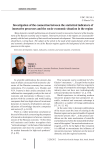
Статья научная
Many domestic scientific publications are devoted recently to innovative character of the development of the Russian economy and its regions. Innovative processes in the regions are associated frequently with the basic priorities of their social and economic development. This innovation assessment should have a strong basis. The subject of the article is the study of the major features of the social and economic development in one of the Russian regions against the background of the innovative processes in this region.
Бесплатно
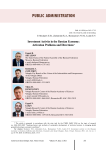
Investment activity in the Russian economy: activation problems and directions
Статья научная
The big challenges facing Russia require ensuring high-quality economic growth which makes it necessary to search for investment resources. However, financial crises, foreign policy pressure, coupled with the export-raw materials model of the Russian economy, do not allow achieving necessary growth investment rates in fixed assets. The purpose of the research is to find and scientifically substantiate ways to enhance investment activity in the Russian Federation. For this purpose, the authors have evaluated parameters of investment activity, have analyzed the sources of financial resources for investment, and have developed specific recommendations to increase investment activity in the Russian economy. The results of the study revealed a number of problems: strengthening of sectoral and territorial disparities, growing dependence on imports of investment goods, deterioration of technological development parameters, reduction of the share of Research and Development and Research and Technological Development in GDP, and reduction of debt financing opportunities. As ways to boost investment activity, the authors propose monetary policy adjustments, expansion of fiscal and tax incentives to support investment and RTD, and development of value chains aimed at smoothing resource allocation imbalances including investment ones. The scientific novelty of the research is in development applied directions for increasing investment activity in the modern Russian economy. The methodological basis is the theory of social reproduction and national accounting. The information base of the research consists of statistical data and materials of the Federal State Statistics Service, the Unified Interdepartmental Information and Statistical Service, input-output tables, the Bank of Russia, the Higher School of Economics, normative legal acts and program documents of the Russian Federation and its subjects, publications of Russian and foreign authors in various periodicals, monographs. Further scientific research will be related to the study of institutional factors of investment activity activation and forecasting the results of implementing the proposed recommendations.
Бесплатно

Investment and innovative vector of agroleasing
Статья научная
The article describes the capabilities of agroleasing as a form of state support for innovative development of baking and grain processing industry through fiscal subsidies for the purchase of new equipment. The benefits of leasing finance schemes of investing in innovative projects compared to commercial bank lending are shown by means of specific calculations.
Бесплатно
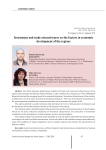
Investment and trade attractiveness as the factors in economic development of the regions
Статья научная
The article discusses performance indicators of trade and investment attractiveness of the regions that comprise the Siberian Federal District; it also considers the consequences of the 2008 global financial crisis and the emerging trends of economic development. Investment attractiveness of the territory is defined by a set of its socio-economic development indicators. The level of investment attractiveness is the most important condition for investment activities and it promotes the quality of life. The authors identify a number of factors that determine the level of infrastructure development and the formation of favorable business climate in the business environment. The article provides a detailed analysis of the growth rates and the volume of investment in fixed capital, which are the main evaluation indicators of investment attractiveness. The attraction of investment contributes to the development of trade relations, services and social sphere. The analysis of trade attractiveness makes it possible to rank the regions of the Siberian Federal District according to the indices of trade attractiveness, which will enable to use available resources most efficiently under the conditions of tough competition and to consider projects that enhance the attractiveness of business entities.
Бесплатно
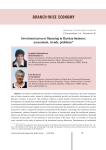
Investment process financing in Russian business: assessment, trends, problems
Статья научная
In modern conditions the provision of investment process financing is the most important task of state economic policy aimed at achieving sustainable growth and dynamic development of the Russian economy in general. This problem solution requires further theoretical consideration and development of appropriate methodological, methodical and practical recommendations. Financing of investment activity development should be based on the systemic approach, which considers this process as an element of the financial support system of the state innovation development. It is necessary to conduct research in order to expand the financial component of this support, encourage the investment process development, enhance financial relations in the sphere of forming and using the intellectual property objects and develop a complex of measures to study the innovations implementation possibilities. Although economic science pays a lot of attention to various aspects of the issue, there is currently no research work, devoted to the study of sources of the investment process financing...
Бесплатно

Investment process in the region: the new century - old problems
Статья научная
The article deals with the investment process in the Vologda oblast, its peculiarities and problems in comparison with the North-West federal district and Russia. The ways to overcome the low investmentactivity with the increasing role of the government regulation in the region are determined.
Бесплатно

Статья научная
In the changing global geopolitical and geo-economic conditions, the issues related to sustainable growth of the national economy, promoting its pronounced development dynamics and providing it with high technology are among the most important directions for Russia's modern economic policy. The priority tasks of national development require an inflow of large-scale investments in the economy, but the question of their rational distribution remains open, so that the attention of investors is directed mainly toward resource-based activities. At the same time, knowledge-intensive industries, which should be at the forefront of new industrialization, are experiencing a clear lack of investment and are in a state of stagnation. In particular, the above is true for a group of Russia's old industrial regions, in which the described situation is even more serious and leads to de-industrialization against the background of insufficient amount of investment at hand. In this regard, the goal of the paper is to analyze investment processes and assess their impact on the changes in the structure of industrial production on the example of old industrial regions of the Northwestern Federal District. We have chosen this object for our study due to the fact that these subjects of Russia occupy one of the worst positions among all old industrial territories according to a number of economic and social parameters. Scientific novelty of our work consists in the need to reveal modern patterns of socio-economic processes and identify structural deformations in the economy. The findings of our study reflect the current state of investment processes and the nature of structural transformations in the old industrial regions of the Northwestern Federal District, taking place against the background of strengthening resource-based industries. Practical significance of the findings is determined by the fact that they contribute to a better understanding of the current socio-economic situation of the sample under consideration and are useful for further study of the specifics of these territories and the problems they face.
Бесплатно
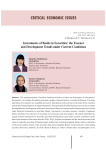
Investments of banks in securities: the essence and development trends under current conditions
Статья научная
The implementation of modern banking activities involves the realization of investments. Investment is a complex discussion economic category, characterized by a number of features. The types and forms of investment are manifold and can be transformed with account of the state of the economy and the level of development of industrial relations. The faster growth of the financial sector in the economy has stipulated the development of financial investment. Banks as financial and lending institutions actively make financial investments in securities. Banks' investment in securities pursues a number of purposes which determine the selection of securities for investment and their quality. The article identified the targets of bank investments in securities and their development trends under current conditions on the basis of the analysis of the actual data for 2010-2014. Negative revaluation and the actual decrease in the value of corporate securities of Russian issuers reduce their commercial appeal...
Бесплатно

